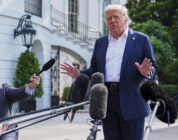Only days after protests against the administration’s immigration crackdown began in Los Angeles, President Donald Trump has ordered almost 5,000 troops — including 700 Marines — to the city in a stunning display of force.
But the president hasn’t invoked the Insurrection Act, required for the military to conduct law enforcement on American soil.
“You have violent people, and we’re not going to let them get away with it,” Trump told reporters Sunday, while also noting he didn’t think the violence amounted yet to an “insurrection.”
The deployments, experts and former defense officials say, are technically legal but leave the military performing an awkward and potentially hazardous mission. The troops have been ordered to protect federal personnel and property amid the city’s protests, which appeared to quiet Monday night.
Still, deploying them to an active protest zone risks making the units look as though they are conducting law enforcement, multiple sources said. Even more, sending them without the consent of the local government could drag the military into the deeply uncomfortable world of partisan politics, with lasting consequences.
“It is something we should be prepared to do but it should be a last resort,” said a former defense official, speaking on the condition of anonymity to avoid retaliation.
The troops approved to deploy to Los Angeles now include 700 active-duty Marines and 4,000 troops from the California National Guard who are operating under Title 10, or federal, authority.
“Due to increased threats to federal law enforcement officers and federal buildings, approximately 700 active-duty U.S. Marines from Camp Pendleton are being deployed to Los Angeles to restore order,” Defense Secretary Pete Hegseth posted to X on Monday evening.
Pressed by lawmakers about the deployments during a House Appropriations Committee hearing Tuesday, Hegseth said the active-duty troops would also provide extra security for Immigration and Customs Enforcement officers operating in the region.
“We believe that ICE, a federal law enforcement agency, has the right to safely conduct operations in any state and any jurisdiction in the country,” he said.
That mission — called “defense support of civil authorities,” or providing military assistance to civilian agencies — has been invoked by the Defense Department in the past, most recently to support immigration controls at the southwest border.
But in this case, Trump has tasked the troops to protect immigration officers and federal buildings in downtown Los Angeles and the surrounding area — not contain the protests directly.
That said, multiple experts described this mission as a distinction without a true difference. Sending almost 5,000 troops to an area of unrest was almost certain to chill any further protest, peaceful or not.
“This is a technique for getting around some of the legal restrictions,” said Lindsay Cohn, who studies civil-military relations at the Naval War College but was not speaking on behalf of the U.S. government.
Without having the Insurrection Act invoked, the Defense Department has strict rules on what troops can do on American soil. For example, U.S. forces can’t conduct searches and seizures, make arrests or use force except in the case of self-defense.
Still, congressional Democrats have expressed serious concerns about the parameters of the deployments.
“The president’s decision to call in the National Guard to Los Angeles was premature, and the decision to deploy active-duty Marines as well is downright escalatory,” said Rep. Betty McCollum, D-Minn., ranking member of the appropriations committee’s defense panel.
“Active-duty military have absolutely no role in domestic law enforcement, and they are not trained for those missions.”
Given the unusual nature of the mission, troops are rarely trained in advance for deployments like the one occurring in Los Angeles. Instead, the units heading into the city are likely being briefed by lawyers or other subject matter experts on what authority they have and what specific tasks they will perform.
“This is almost always just-in-time training,” the former defense official said.
California government officials have also objected to the deployments, with the state’s Democratic governor, Gavin Newsom, filing a lawsuit Monday to have the troops removed.
“The absurdity of threatening the people of the United States of America with their own military is morally reprehensible,” Newsom posted on X.
The last time the federal government deployed troops to a state without local consent was in 1965, when President Lyndon B. Johnson tasked the military to protect civil rights demonstrations in Alabama during segregation. Trump considered invoking the Insurrection Act during the widespread protests against police violence in 2020, though ultimately held off.
In Los Angeles, Marines were sent in to help quell rioting after a jury acquitted police for beating Rodney King, an unarmed Black man, in 1992.
One of the reasons those troops helped resolve the violence 30 years ago was that they were seen as a neutral party, not responsible for the police violence that angered so many people in the city, said Carrie Lee, a senior fellow at the German Marshall Fund.
Trump’s executive order over the weekend permits the administration to deploy troops to cities where protests are either occurring or “likely to occur,” a broad description that may allow forces to operate in other cities if the demonstrations spread.
Tasking the troops to support the target of the protests — in this case immigration officers — may make them more controversial themselves, Lee said. Rather than an impartial actor, the military may look more like a political one, she argued.
Uniformed officers usually avoid any situation that may make them appear to be partisan, said Cohn. But even so, they’re content to follow orders.
“They have to respond, but they won’t be happy about it,” Cohn said.

![NTAG Mid America XO Enlists Son into Navy [Image 3 of 4]](https://www.navycrf.com/wp-content/uploads/2024/10/250w_q95-ugAPFy-178x140.jpeg)
